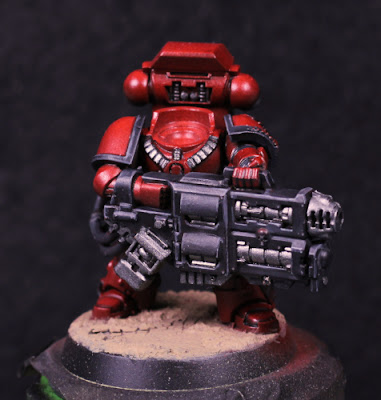 |
| This is really heavy. |
Well. A few things have prevented me doing much for some weeks, and it's not likely to let up anytime soon. This means something has to change if I'm going to get any painting done and models actually finished. These stalled Devastator Marines are going to serve as a bit of practice in that regard.
The number one thing that stops me is not knowing how to paint various bits & pieces. What colours to use, what material I'm trying to represent, that sort of thing. I'm slowly solving that with references to models already painted, but also going by box art to decide. The latter doesn't show everything though, notably it only typically has a single view point and rarely shows the backpack - so even with box art I still need to spend time deciding what colours go where.
Related to that is the number of paints to apply: switching paints out all the time is very demotivating, especially with my current setup where the paints are actually in another room. I generally need to know which ones in advance, get them all, lay them all out on my (small) wet palette, and make sure to stretch that as far as it will go before starting all over again. It suits my painting style of focusing on details, but it's very slow to make obvious progress.
Slow painting is its own demotivator - the less I paint, the less I want to paint. It's very hard to break that cycle, which is why tackling something that makes a bit visual change is always a good idea - but I'm running out of that on these models.
So what to do? I think I've come up with a plan to tackle the above problems and get back to painting, to a degree. First I'm going to focus on a single model at a time for the Devastators. That's not to say I won't batch paint where possible: all purity seals for example can be done at the same time, it's just that other models will be done as more of an afterthought against the primary. This will keep visual changes more frequent, and fits in with these particular models all being that little bit different (a hallmark of Blood Angels as they used to be designed).
The next idea is to simply reduce the number of paints used and rely on "good enough". I've been using metallics for skull icons recently for example - only three or four paints for all the little details across the whole model. The idea is to break up monotonous surfaces rather than show off as many paints as possible. The weapons are going to be black, metallic, and some minor details. Edge higlighting I'll try make more apparent to show off the shapes, otherwise just keeping the colour palette very simplistic.
Finally I'm trying to paint smarter by using paints to their strengths. In this example I make sure to paint most details with a layer of Black Legion for the simple reason that it helps later layers adhere and cover better. The varnish layer normally takes many coats of paint before everything covers properly - but even a single thin layer of high pigment Contrast acts as both primer of sorts and pull back excessive red in areas. Black Templar mixed with some acrylic flow improver turns into a sort of Nuln Oil, and flows nicely into the joints.
All the above I've started to do on the weapon and shoulder pad trim. It was a marked improvement in speed and let me actually assemble everything. Of course the arms didn't quite line up properly and I had to use putty to help them stick (it looks really ugly from the rear), but I was expecting that to happen on at least one model. The price I pay for sub-assemblies. From here I'll start to fill in some details and try get this one model done, moving on afterwards to the rest of the squad.
-- silly painter.







